Since I located an old house that is a monument of culture, which I wrote about in the previous sequel of my travel stories, I went to a church in the very centre of Čačak. This is the Church of the Ascension of Our Lord that is a cultural property of great importance.
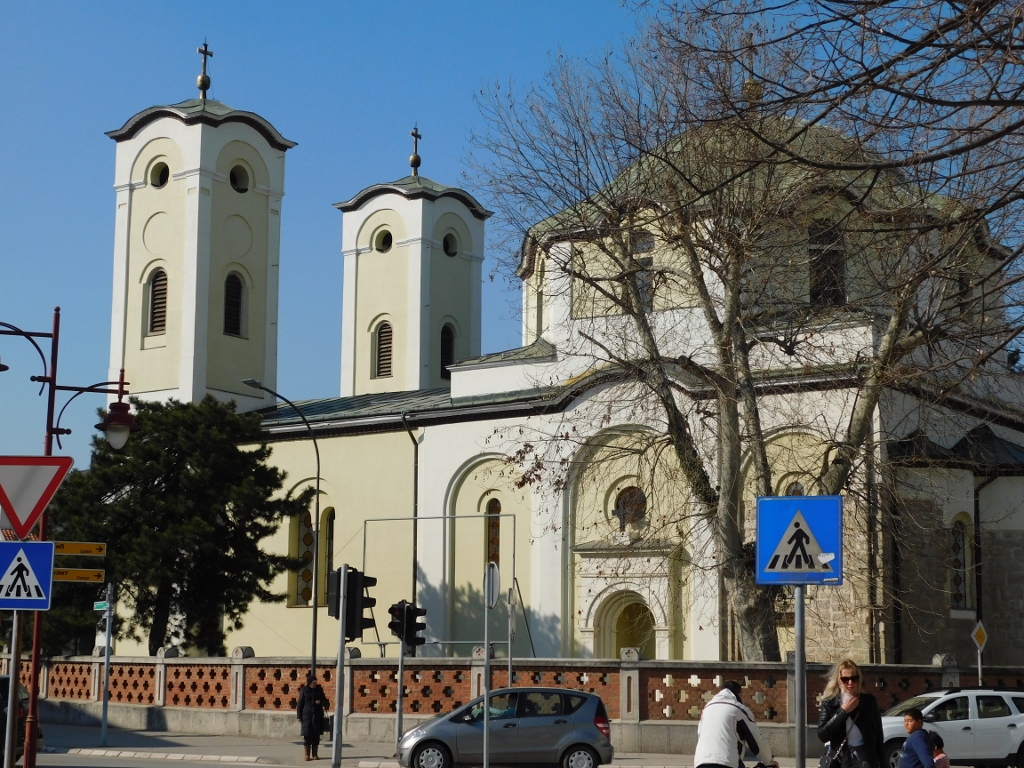 Church of the Ascension of Our Lord
Church of the Ascension of Our Lord
The church was built over the remains of the Monastery of the Holy Virgin of Gradac from the end of the 12th century that was mentioned for the first time in 1207-1215. The Holy Virgin of Gradac was the endowment of Prince (Župan) Stracimir, brother of Stefan Nemanja, and it was considered as one of the most important Serbian medieval endowments. Still, during the period when Čačak was mostly under the Ottoman rule (1459-1834), the church was turned into a mosque three times (the border kept moving and consequently who the real ruler of this area was). Finally, in 1834 the then mosque was turned into a church once again, consecrated at the beginning of September and dedicated to the Ascension of Jesus.
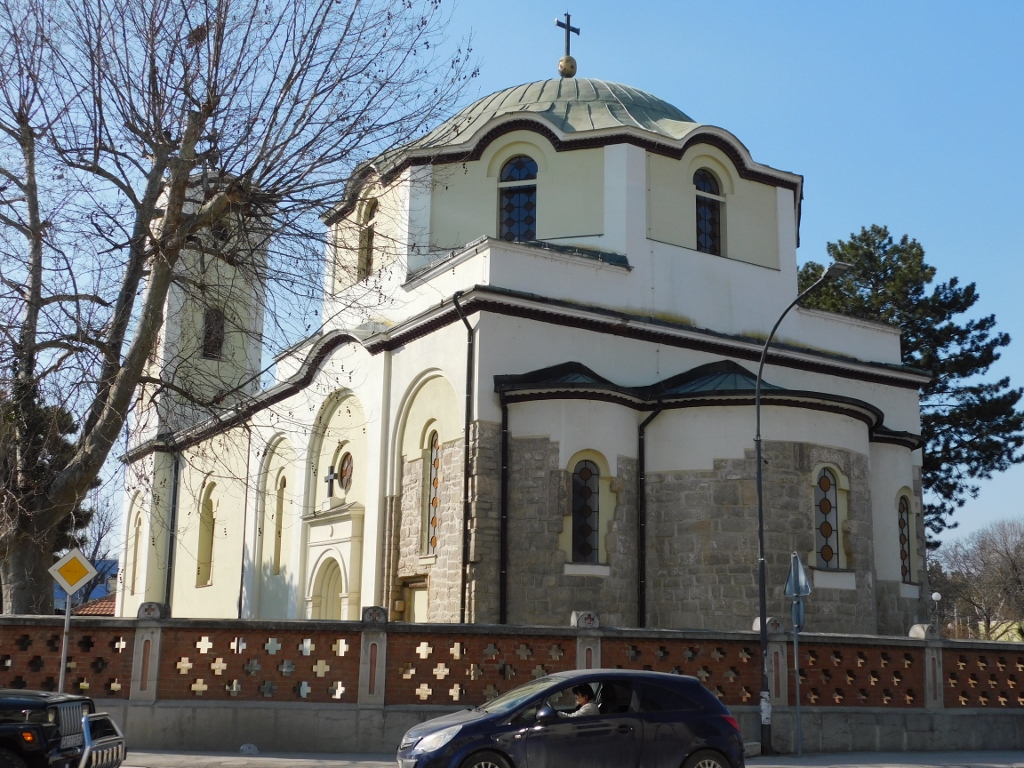 Church of the Ascension of Our Lord
Church of the Ascension of Our Lord
With this number of modifications and repairs, the church certainly kept changing its appearance, but what is important in terms of architecture is that this is a single-nave building, with altar area that includes three apses (as seen in the photo above). What also catches the eye is the rather large dome and this is ascribed to the period when the church was used as a mosque. There are two tall towers at the entrance to the church.
Having entered the church, one can see a monumental iconostasis from the period 1834-1846 and during my visit in March 2022 it was clear that the church was being freshly decorated. Namely, the church was completely reconstructed in 2018-2019 which was then followed by the fresco painting of the walls.
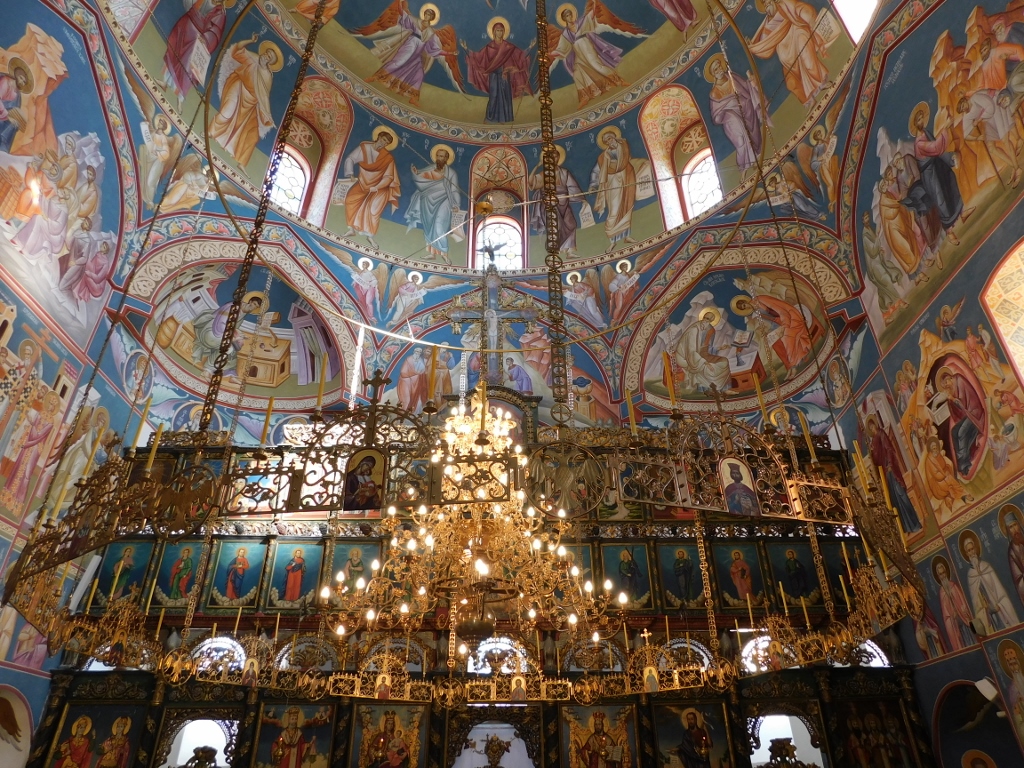 Church of the Ascension of Our Lord, the interior
Church of the Ascension of Our Lord, the interior
To be more precise, during my visit, I could see that the gold leaves were being applied to the halos of the saints depicted in the frescoes.
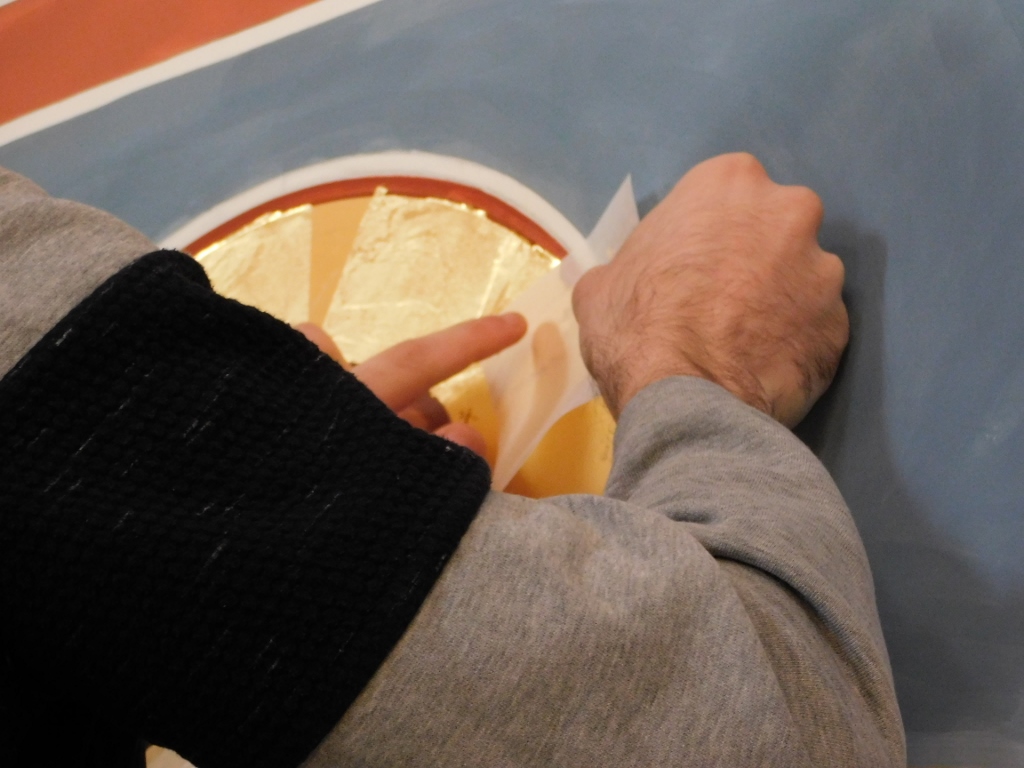 Church of the Ascension of Our Lord, application of the gold leaves
Church of the Ascension of Our Lord, application of the gold leaves
The effect is impressive, especially when the sunrays illuminate the frescoes well.
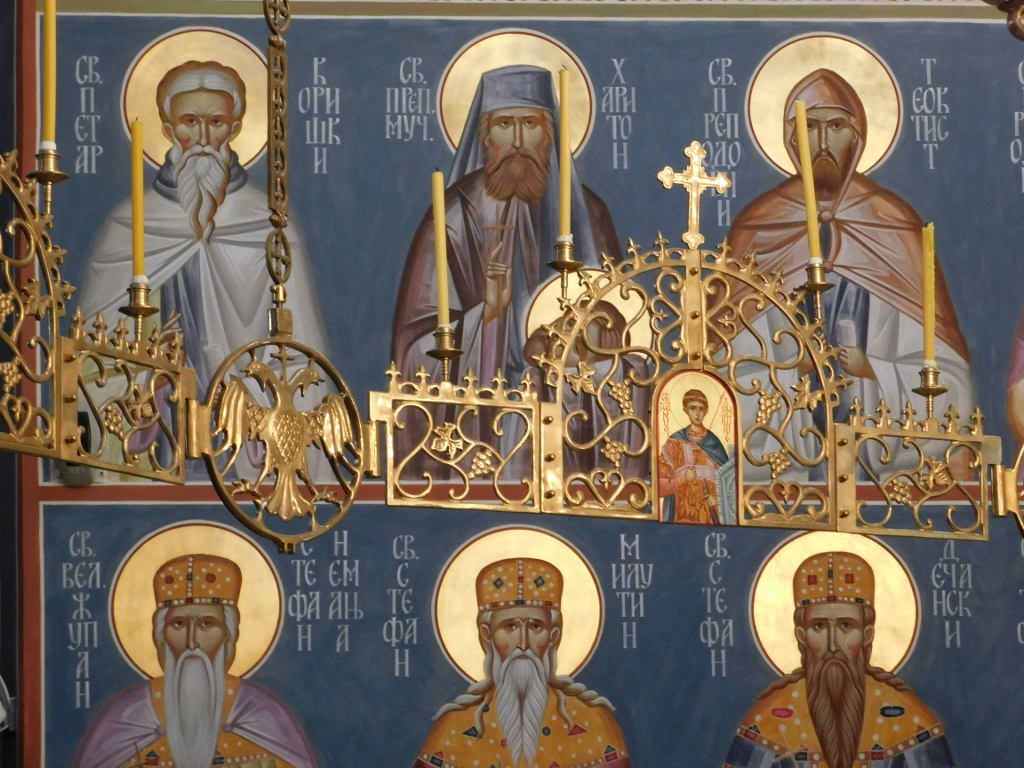 Church of the Ascension of Our Lord, details
Church of the Ascension of Our Lord, details
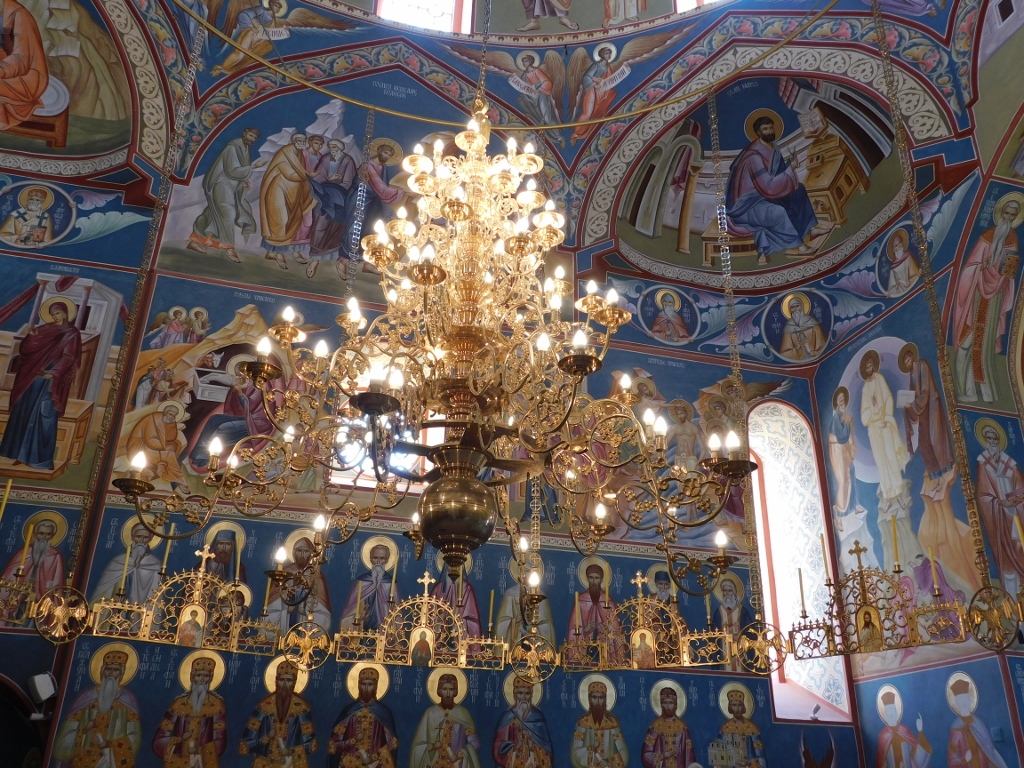 Church of the Ascension of Our Lord, details
Church of the Ascension of Our Lord, details
After I had finished with my visit to the church, I went out and crossed to the other side of the street. This allowed me to have a nice view at the church again.
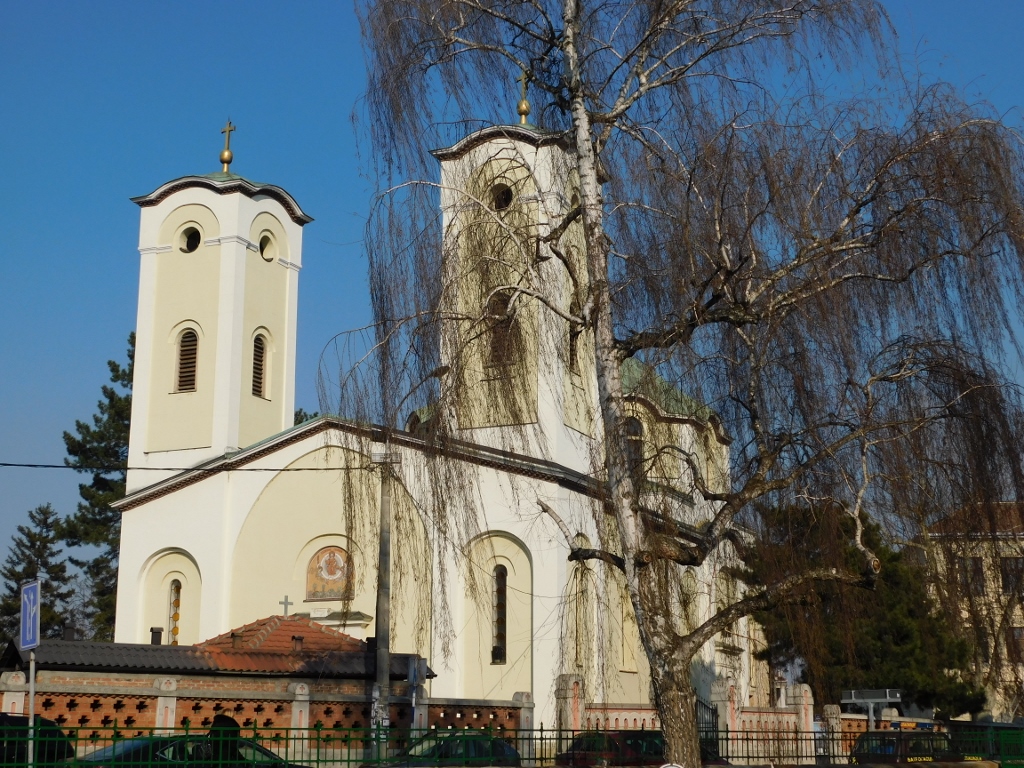 Church of the Ascension of Our Lord in Čačak
Church of the Ascension of Our Lord in Čačak
When I left the Church of the Ascension of Our Lord, I noticed some interesting buildings on the other side and I completely forgot that there was also another very important cultural property of great importance there – the building of the District Administration in Čačak. It does seem to me that the Town Hall in the centre of Čačak, right opposite the Grammar School, allows for a much better view since the layout of the streets and the buildings provide for more free space and therefore the respective buildings can be observed better. As for the District Administration building, it is located in Gospodar Jovanova street which is comparatively narrow and therefore the impressiveness of the building and its front facade may be easily neglected, as was the case with me.
Be as it may, the construction of the building intended for the District Administration and the District Court started in 1875. Whoever goes to Čačak should certainly pay attention to this building since it is truly beautiful. On the other hand, it is not as if I had completely missed the edifice. Oh, no! I even went in, but from the rear where there are premises of the National Museum. It was precisely a smallish park that is situated behind the District Administration Building that caught my attention when I was leaving the church yard and I knew that it was from there that one could enter the National Museum, as well as the House of Jovan Obrenović.
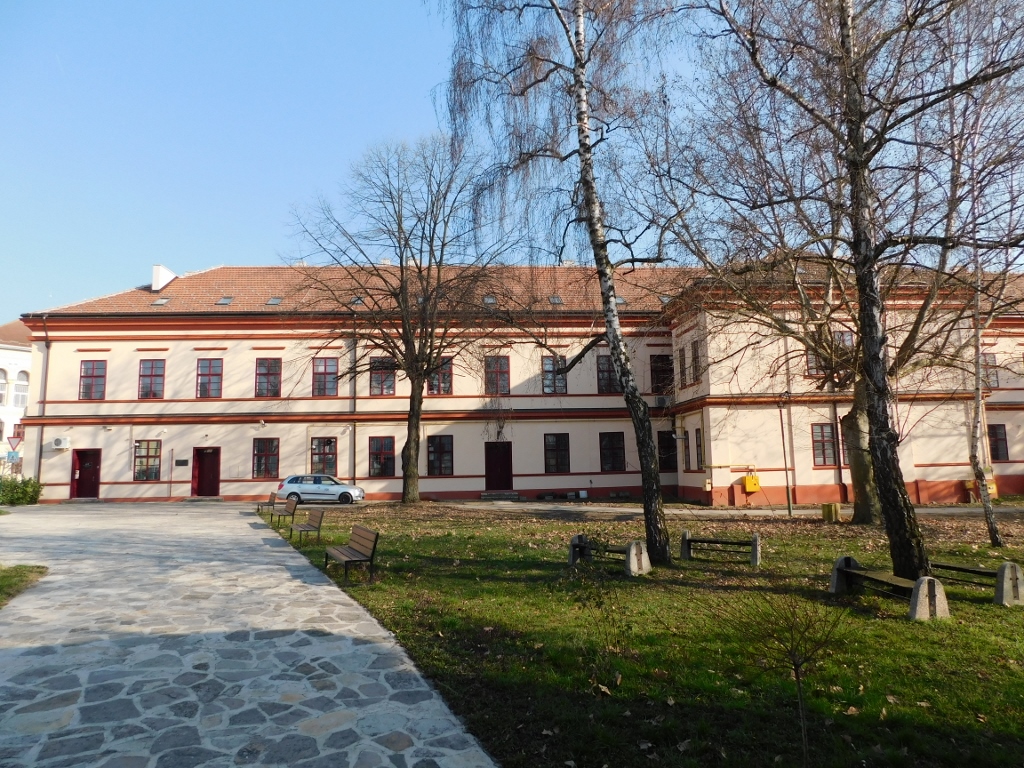 District Administration building – the back side
District Administration building – the back side
The National Museum actually has a couple of rooms on the ground floor within the District Administration building and during my visit these premises were used for an exhibition of mosaics by Bisenija Tereščenko. I went in just like that, unprepared, but I was truly delighted by the mosaics. Although this is not specifically linked to Čačak, I liked them enough to include them here. So, here is a photo of one of the mosaics.
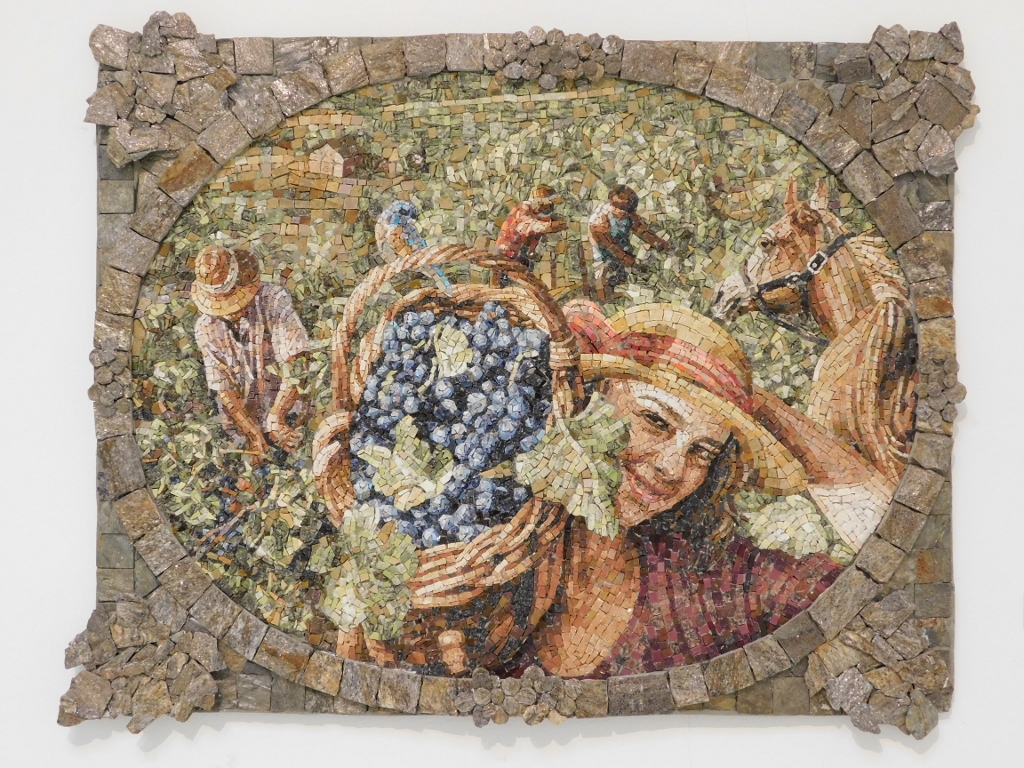 Picking young grapes in the old vineyard
Picking young grapes in the old vineyard
Even though I was very glad that I entered the museum and saw these gorgeous mosaics, I was a little confused, since these premises looked more like a gallery for temporary exhibits. Two kind ladies who worked there then explained to me that one of them would take me across the park to the House of Gospodar (Lord) Jovan in order to unlock it for me, since the permanent exhibit of the museum was displayed there. It was obvious that not many tourists come here.
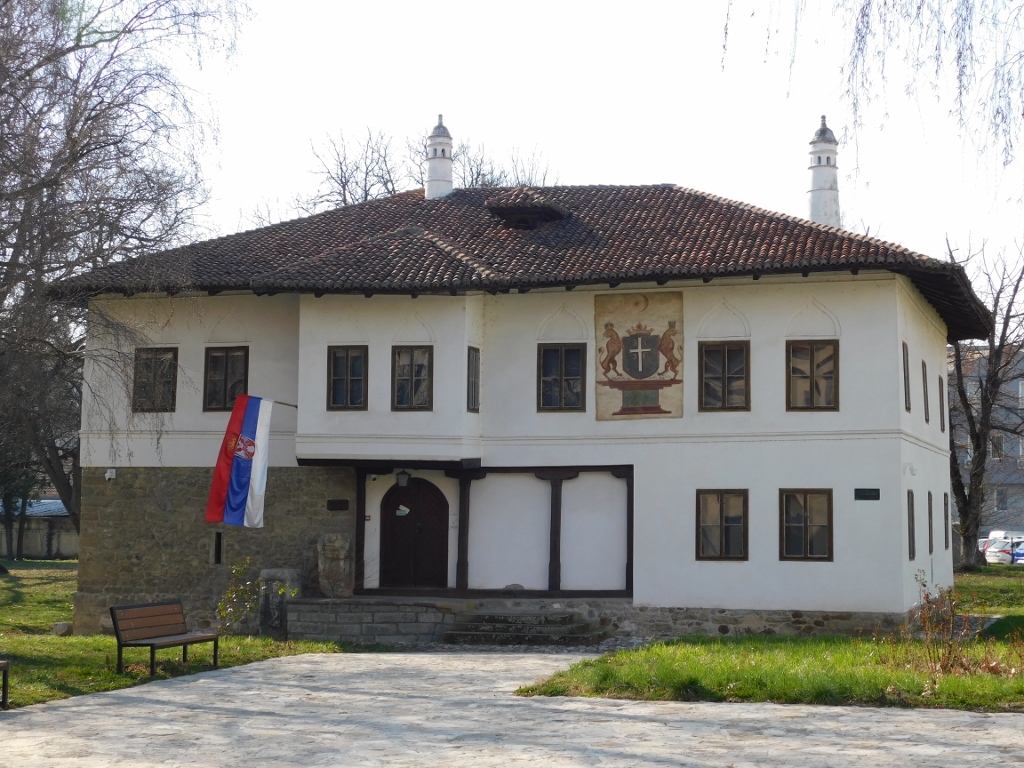 House of Gospodar Jovan
House of Gospodar Jovan
To start with, let me say that the House of Gospodar Jovan is a cultural property of great importance. The building was constructed in 1835 by Gospodar Jovan Obrenović, the younger brother of Prince Miloš Obrenović, who lived in Čačak for a short while. The house is considered to be the oldest in the town and it displays on the front facade the coat of arms of the Obrenović dynasty, the only one preserved in Serbia. Needless to say, the structure went through different alterations over time and it was considerably damaged during the 1941 bombing by Germans. Still, from 1950 to 1953, the building underwent rehabilitation and conservation and restoration works, which brought back the original appearance to the building, including the Obrenović’s coat of arms. Nowadays, it houses the permanent exhibition of the National Museum in Čačak. The exhibit includes the locally important artefacts from prehistory, through the Middle Ages, up until the 19th century uprisings and the 20th century wars (through WWII). In addition to various interesting exhibits, the visitor can also see some details linked to the interior arrangement from the first half of the 19th century, such as the stove that can be seen in the next photo.
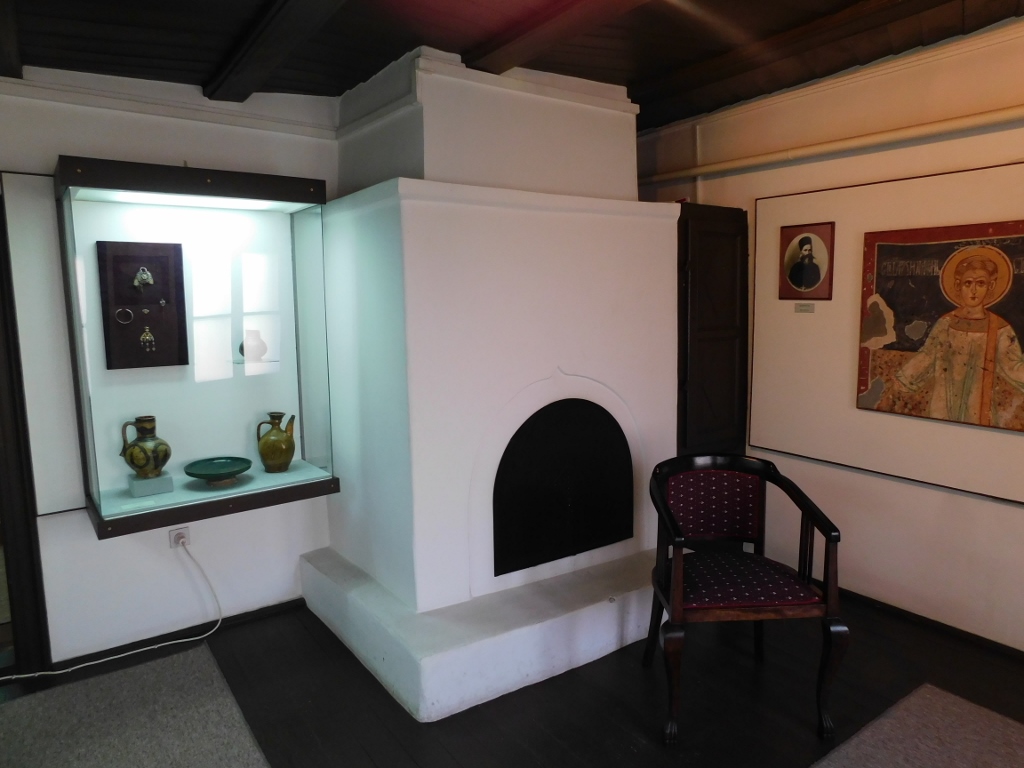 House of Gospodar Jovan, a detail
House of Gospodar Jovan, a detail
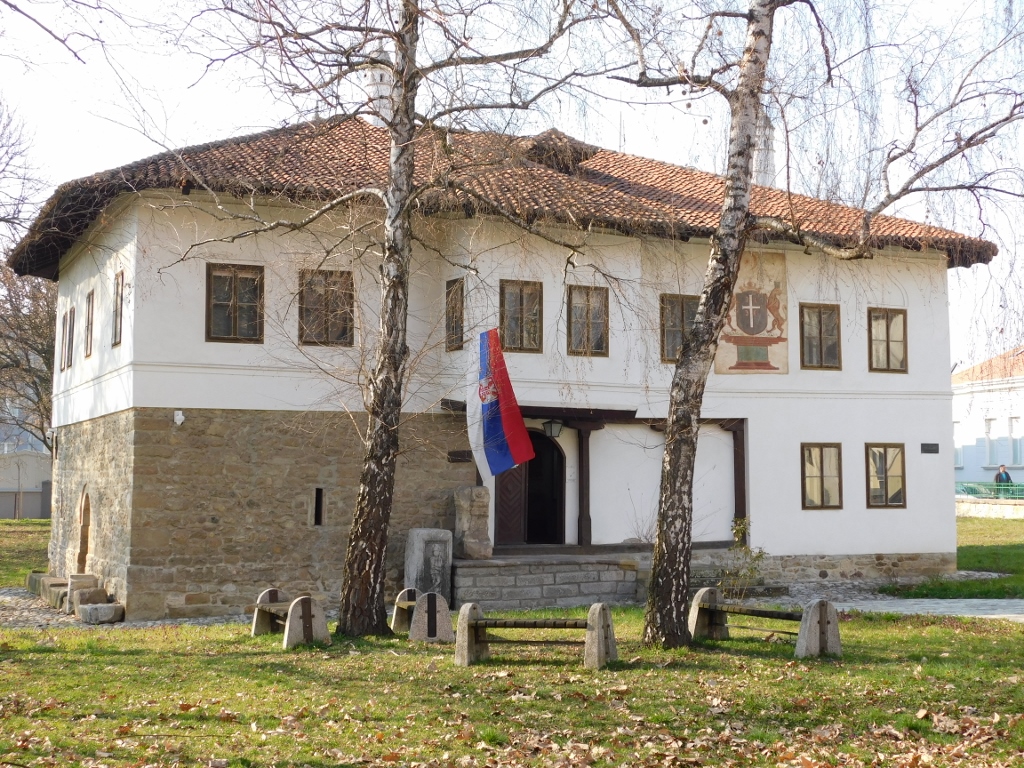 House of Gospodar Jovan
House of Gospodar Jovan
Within this park, just behind the House of Gospodar Jovan, there is a monument to poet Vladislav Petković Dis (1880-1917). Although I did have this marked in the materials I carried with me, it somehow slipped my mind while I was here and I remembered it only a little while later, but then, I must admit, I did not feel like walking back. I will make sure to correct this the next time I go to Čačak. Dis was born around Čačak and went to school here, so this explains the special bond between the town and the poet.
At the time when I visited the town in March 2022, I crossed once again to the other side of Cara Dušana street where there is the Church of the Ascension of Our Lord, for there is also the building of the Art Gallery “Nadežda Petrović” which is a monument of culture.
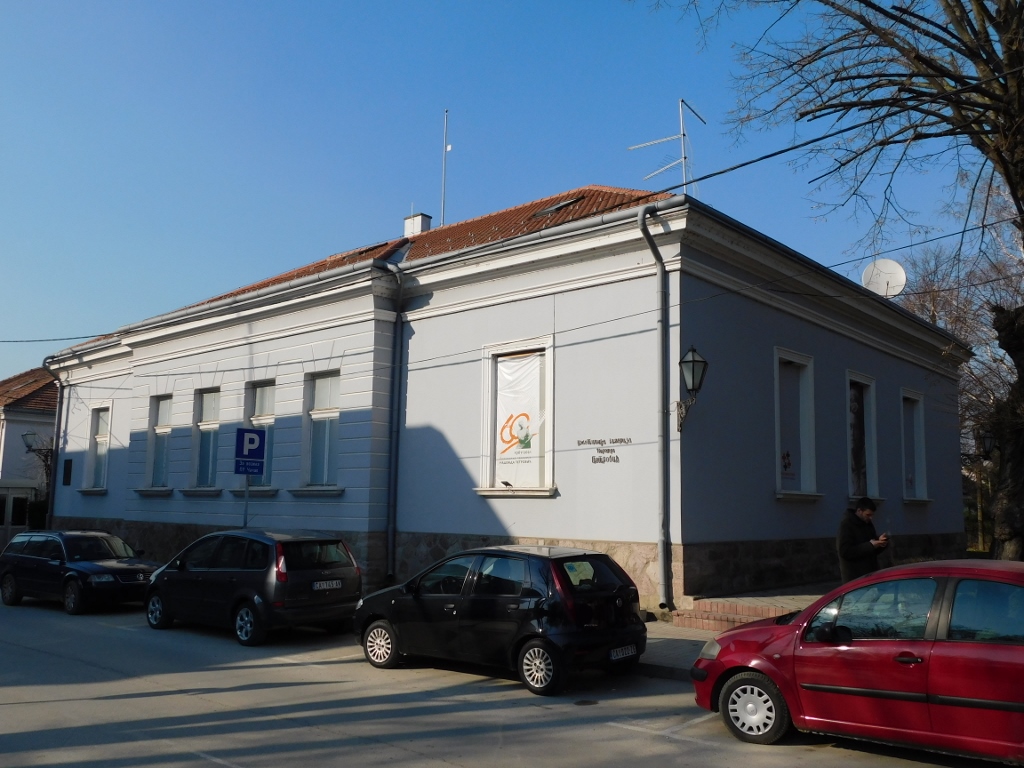 Art Gallery “Nadežda Petrović”
Art Gallery “Nadežda Petrović”
The entrance into the gallery is not from the side of the street, but rather one has to go to the back, where there is space that used to be the yard. The building was constructed in 1911 and it first served as a female school that operated up until 1948, with breaks during the Balkan wars and World Wars I and II. Since 1965, the building has been used as the Art Gallery named after painter Nadežda Petrović that I wrote about in the previous sequel of my travel stories. I had received very good recommendations for this gallery, but when I got to the entrance it turned out the door was locked. Perhaps the employees had their break, but whatever it was I could not enter. The visit to the gallery will also have to wait for my next visit to Čačak.
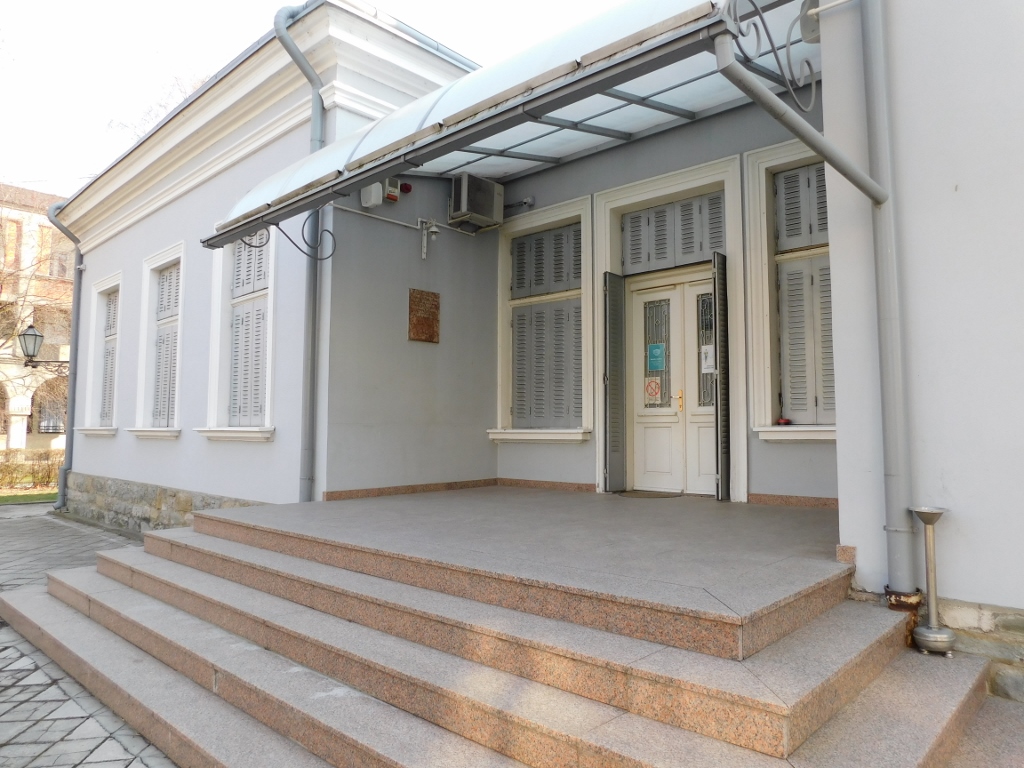 Art Gallery “Nadežda Petrović,” yard side
Art Gallery “Nadežda Petrović,” yard side
Further in the continuation of the same street and on the same side there is another monument of culture and this is the Sokol House in Čačak.
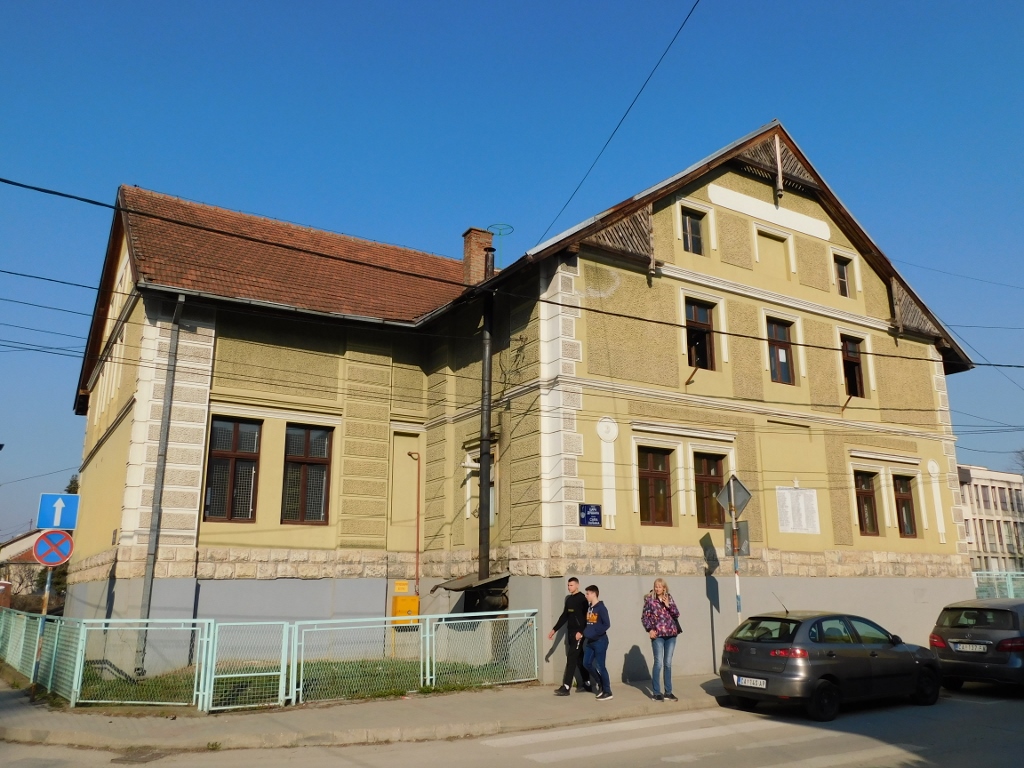 Sokol House in Čačak
Sokol House in Čačak
The Sokol movement was founded in Czechia in 1862 with an idea to use physical exercises with the young people in order to develop concurrently their moral and intellectual capabilities. In other words, this was the practical application of the ancient motto Mens sana in corpore sano, i.e., “A sound mind in a sound body.” One of its founders was Miroslav Tyrš and I find it interesting that the street in Belgrade in which there is the University Children’s Clinic has been named precisely after this Czech doctor of philosophy and consequently the hospital is often called Tyrš’s clinic.
Well, this movement named after the Czech word for falcon has spread a lot in the regions populated by the Slavs. By the way, since I’m talking about the meaning of the words, a very close notion is the word “slet” which is used to mark a mass gymnastics festival, while the first Sokol slet was organised in 1882. The word “slet” (mass games) comes from the Czech word for the flocking of birds. In former Yugoslavia we used to have a traditional slet for the Day of Youth (25 May) and this was something when the whole country was glued to their respective TV sets.
All in all, the point is that the Sokol movement is linked to the young people and to the importance which sports have in their overall development, not only as the means for the development of the body, but also of the spirit. The cornerstone for this building was laid down at the end of 1912 and irrespective of the Balkan wars the construction continued, so the building was completed in the spring of 1914. Still, because of WWI, the damages to the building and the slow reconstruction, the Sokol House was opened only on 22 June 1926. It is important to point out that although the movement was originally intended for young men, over time the importance of physical exercises spread to women as well and so the Sokol association played its role in equalling the position of genders by organising exercises both for female and male members. Already in 1926 they had a female head who was in charge of female members of the Society. The first library in Čačak was also founded in this building in 1931.
Nowadays, it houses the Sport Centre “Mladost” and the Sport Hall “Sokol House,” so it was really nice to see that the building is still used for the sport activities of the young.
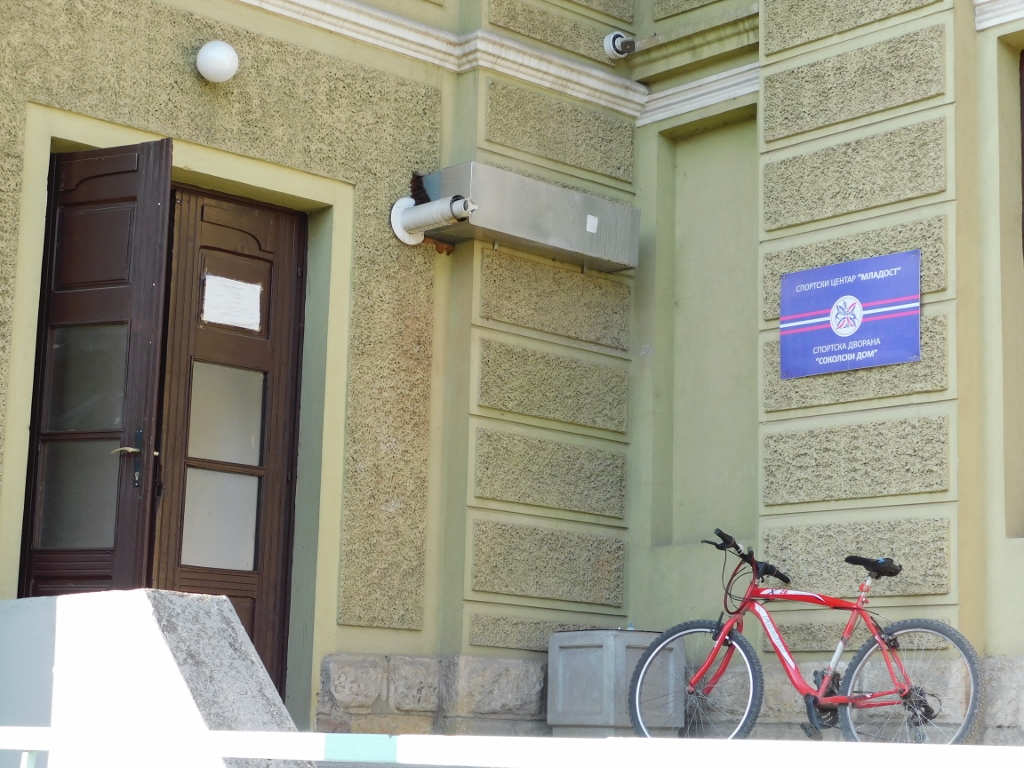 Sokol House in Čačak, the entrance
Sokol House in Čačak, the entrance
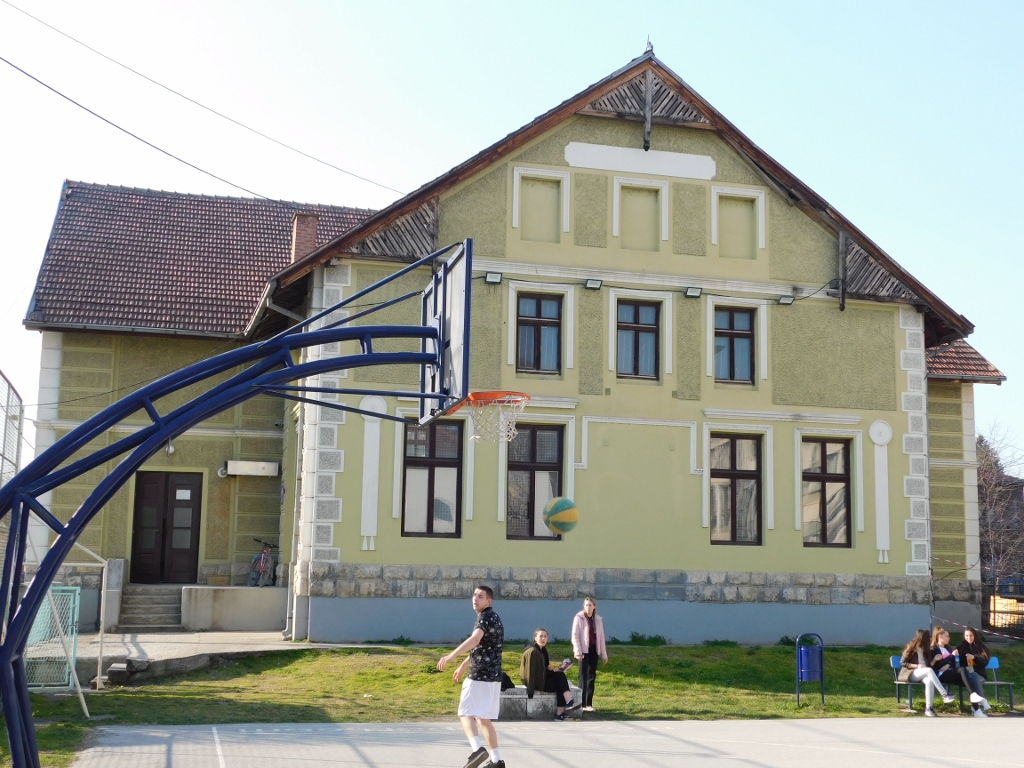 Sokol House in Čačak, the basketball court
Sokol House in Čačak, the basketball court
Not far from here there is also the Fruit Research Institute. The complex of buildings within this institute, the oldest one of which was constructed in 1898, is a monument of culture. In addition to the construction of the first building, this year also marked the beginning in the development of the nursery with the goal to enhance fruit growing and viticulture. A new administration building was constructed in 1947 and thanks, among other things, to the cooperation with some institutes from abroad in this period, the largest collection of different fruits in the Balkans has been created.
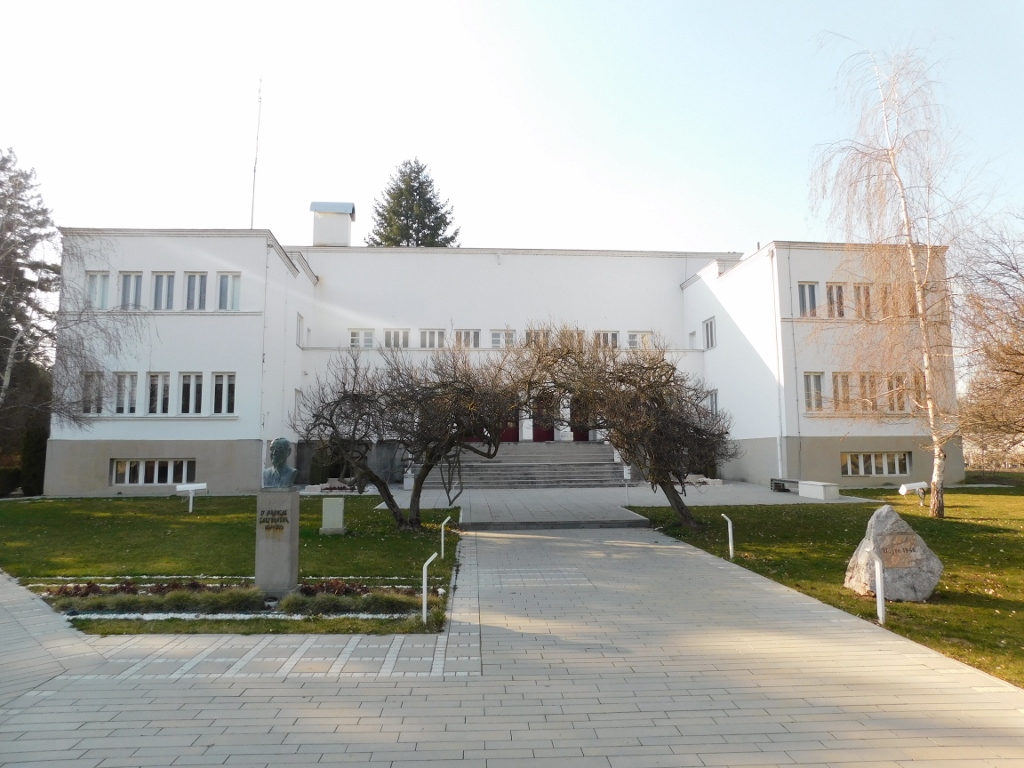 Fruit Research Institute
Fruit Research Institute
This institute is primarily important because its operations allow us to see the development of fruit growing and viticulture in Serbia over the last 120 years. A lot of people have probably heard of different plum varieties that have čačanska (from Čačak) in their name, but here one can buy seedlings of other fruits as well. In other words, in addition to plums, the Institute also offers different varieties of pears, apples, cherries, sour cherries, apricots, quinces, raspberries, hazelnuts and walnuts. So, if you are visiting Čačak and have where to plant young fruit trees, make sure that you stop at the Institute in order to buy good quality seedlings.
Not far from the Institute, I passed by a building that had a lovely mural. In addition, to the right from the entrance, there was graffiti. Generally speaking, I’m very much against any kind of scribbling on buildings, since somebody lives there and it should also be nice for the people passing by, but I must admit that I appreciated what this graffiti was saying (Politicians are a..holes). I only think the authors could have kept their opinion to themselves, as I do, or to write it in some other place.
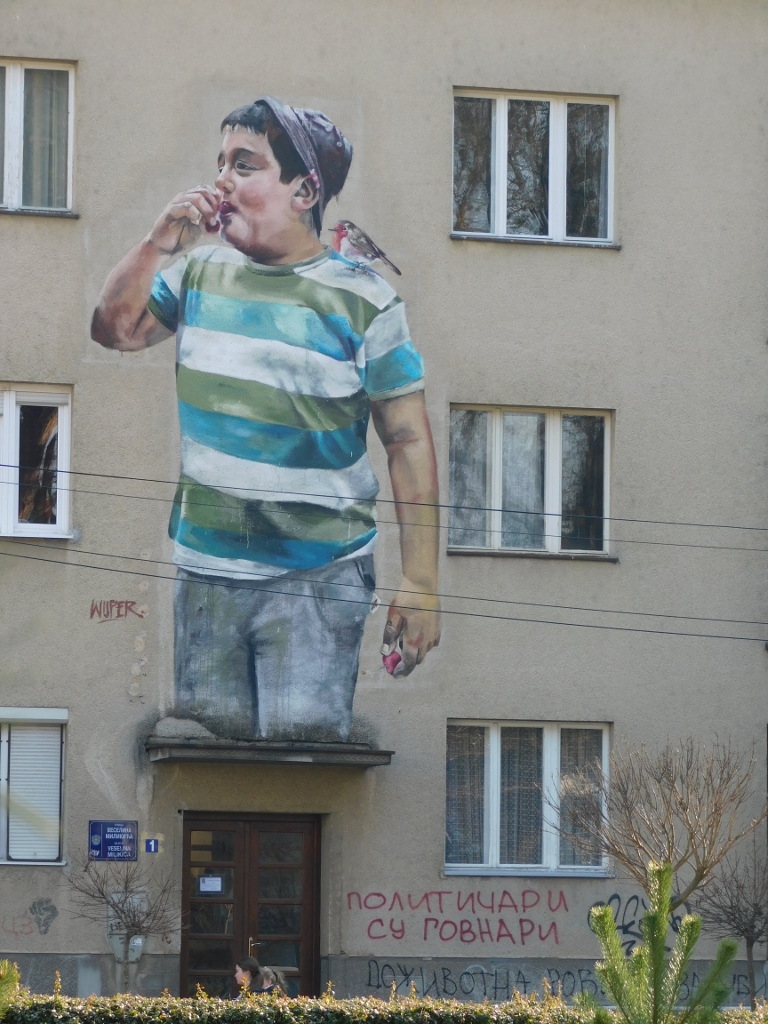 A building in Čačak
A building in Čačak
Then I walked to yet another monument of culture and that was the Teachers’ House in Čačak. This is a building made as the endowment of a Teachers’ Association, the purpose of which was to provide accommodation for the children who attended school in Čačak, but who did not reside here permanently, while coming from poorer teacher families.
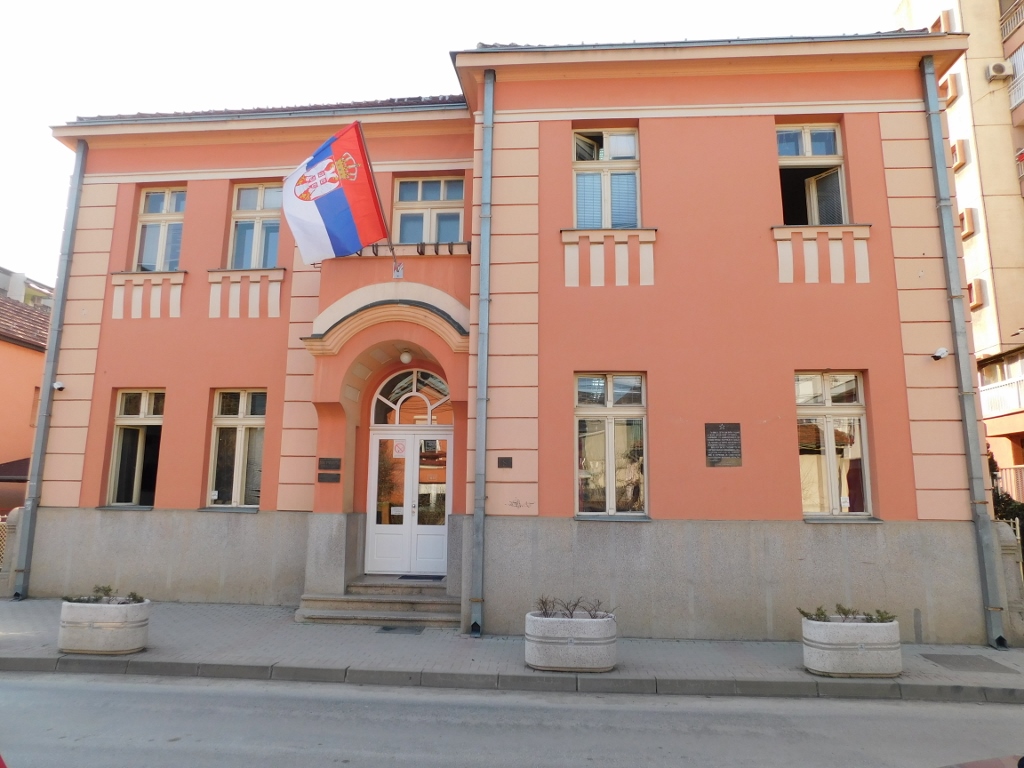 Teachers’ House
Teachers’ House
Nowadays there is a modern, new Home for the Secondary School Students which practically has the same purpose as the old one, but this building seen in the photo above from almost 100 years ago is important because it bears witness to the endowment activities in Čačak and Serbia, because it was built using voluntary donations of the teachers from the surrounding districts.
The next monument of culture I walked to was the House of National Hero Ratko Mitrović.
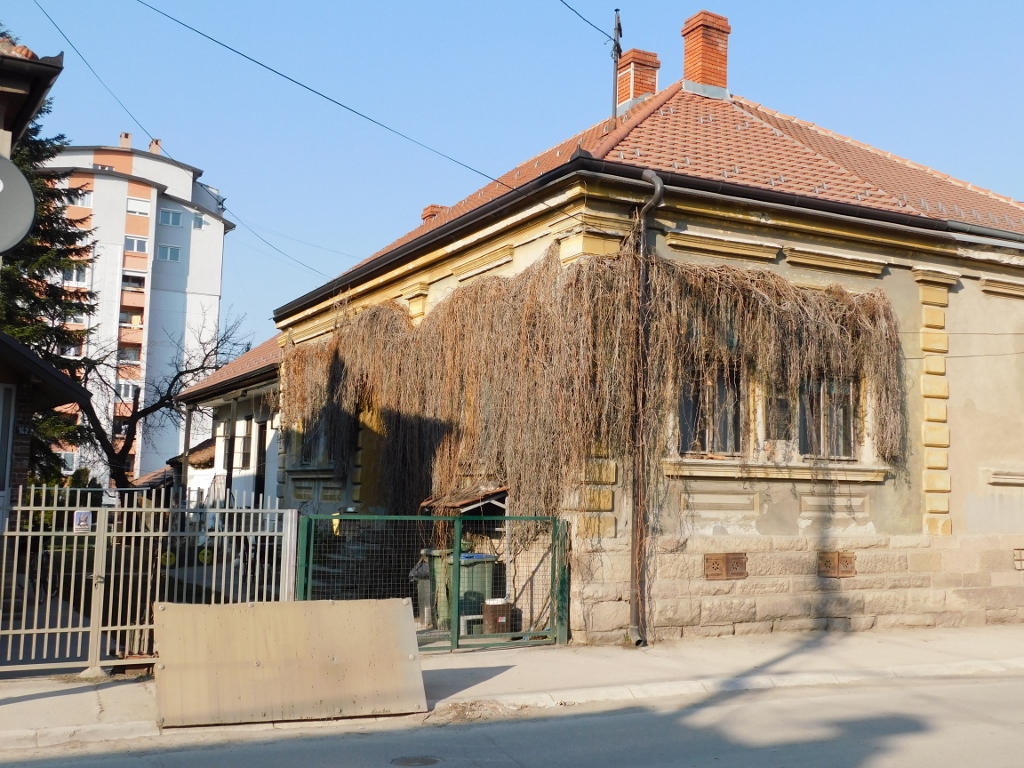 House of National Hero Ratko Mitrović
House of National Hero Ratko Mitrović
Although the materials I had on me said that the architectural features of this house testified to the development of the town at the beginning of the 20th century, I must admit that I think the main criterion in this case (and even more in one of the next ones) is that this was the birth house of a famous National Hero from WWII. I have nothing against it; I’m just mentioning this. Ratko Mitrović was a partisans’ political commissar. He was arrested at the end of 1941, then he was tortured and eventually hanged in the open market in Čačak. He was arrested by the Chetniks who handed him over to the Germans, I did not manage to find out who actually tortured him, but in the end he was hanged by the Germans. Rather medieval on the part of the Germans who considered themselves to be a higher race, isn’t it?
The house looks somewhat prettier later in the spring and in summer when the plant covering the facade gets its foliage, but despite the sunny day, it was still far too early in March to have the greenery. And yet, that did not prevent a local resident from enjoying the beautiful and comparatively warm weather.
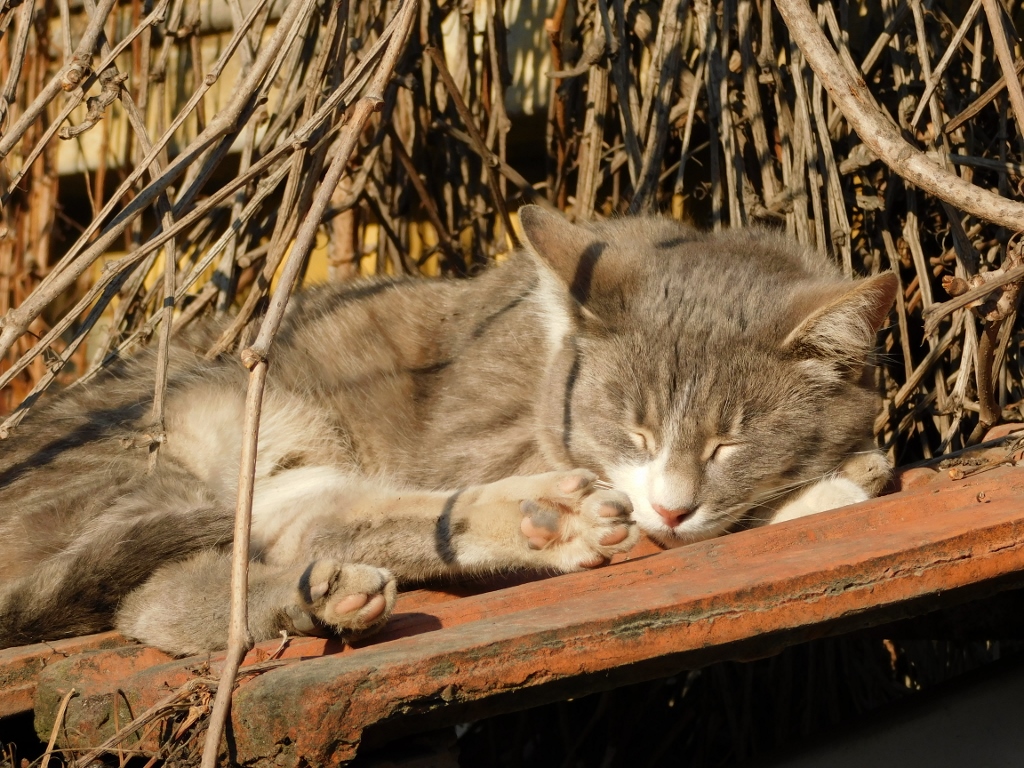 Enjoying and napping in the sun in the yard of the House of National Hero Ratko Mitrović
Enjoying and napping in the sun in the yard of the House of National Hero Ratko Mitrović
After this, I returned to the centre of Čačak, to a small square from which the pedestrian street Gradsko šetalište starts. There is a monument to Vojvoda Stepa there. I have already written about Vojvoda Stepa Stepanović in the previous sequel of my travel stories dealing with my trip to Čačak and Ovčar Banja.
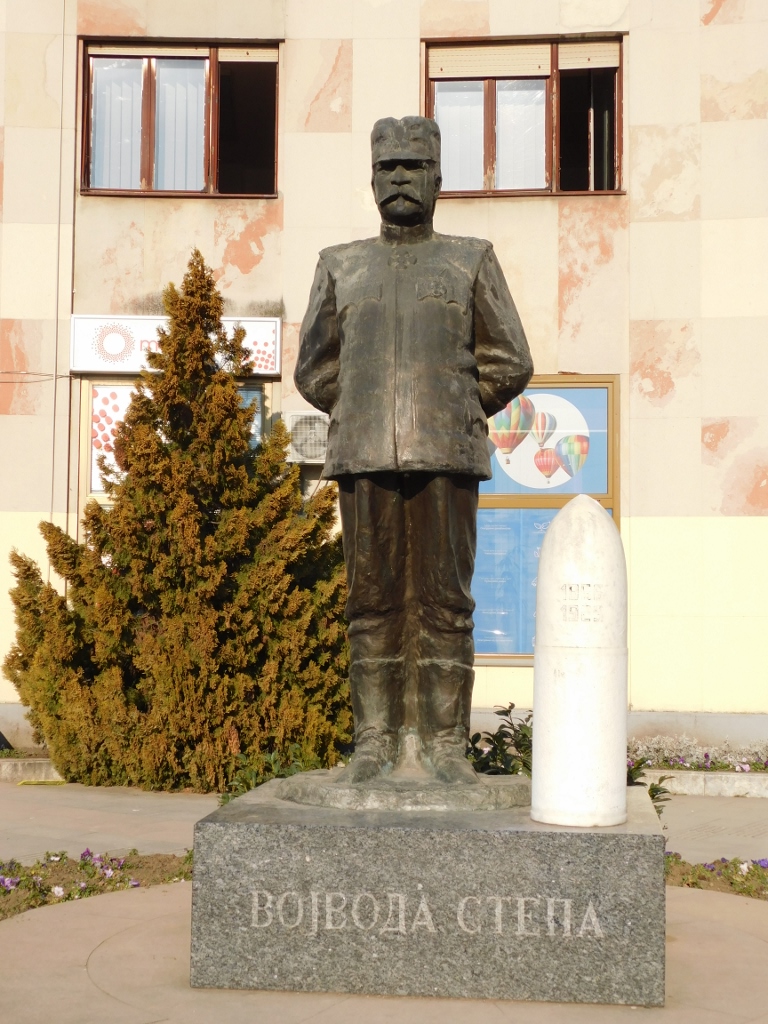 Monument to Vojvoda Stepa
Monument to Vojvoda Stepa
Right across the street, there was the building for which I had the old address that was unusable. This is the House of Aleksa Pušeljić from 1905.
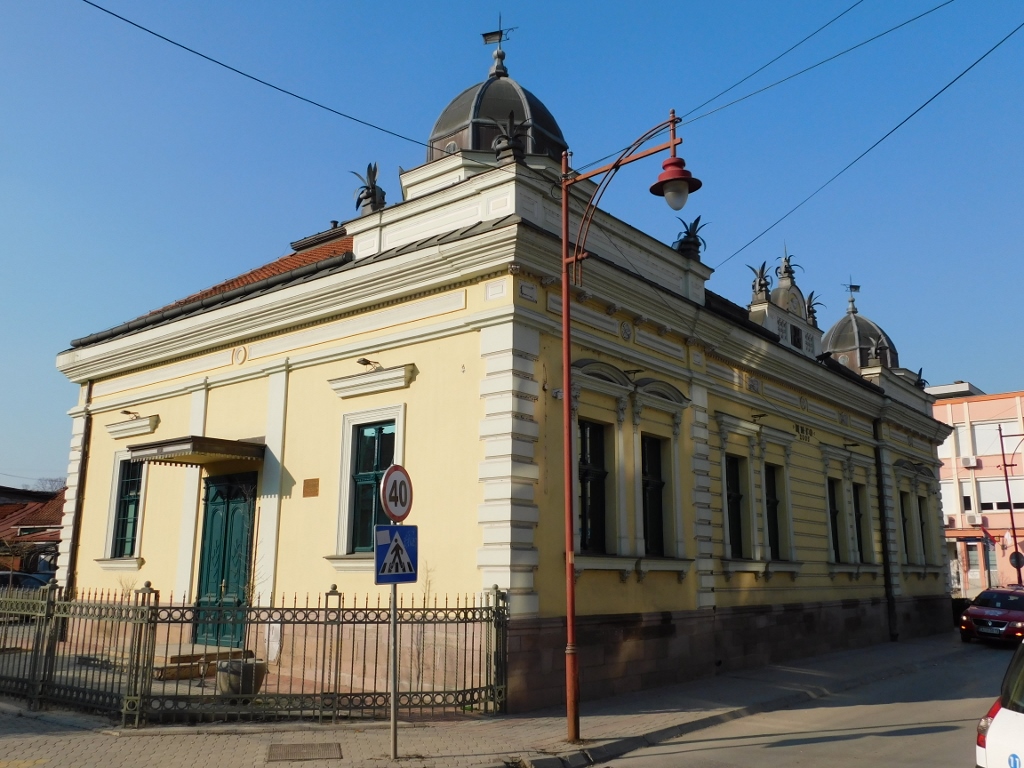 House of Aleksa Pušeljić
House of Aleksa Pušeljić
The building is considered to be one of the most representative old buildings in Čačak and it was made in the eclecticism style. The details may be seen in the next two photos, but I would particularly like to emphasise that the following photo shows, between the blind balustrades and under the lunette with the depiction of Amor, the year of construction and the Cyrillic monogram АП (AP).
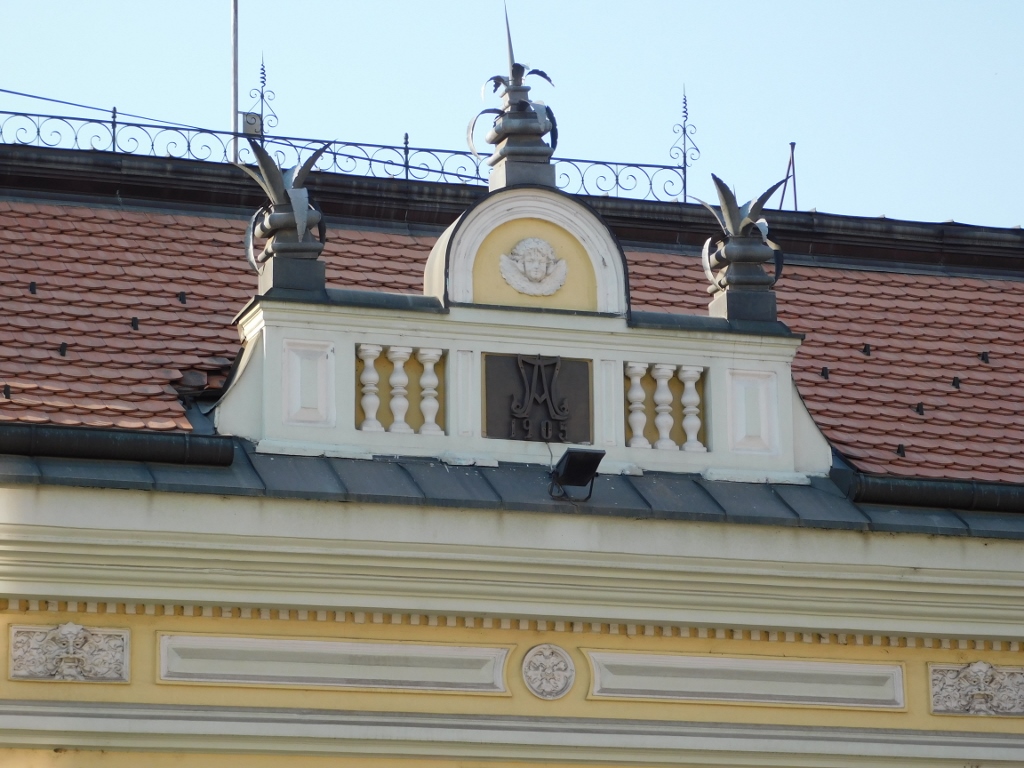 House of Aleksa Pušeljić, details
House of Aleksa Pušeljić, details
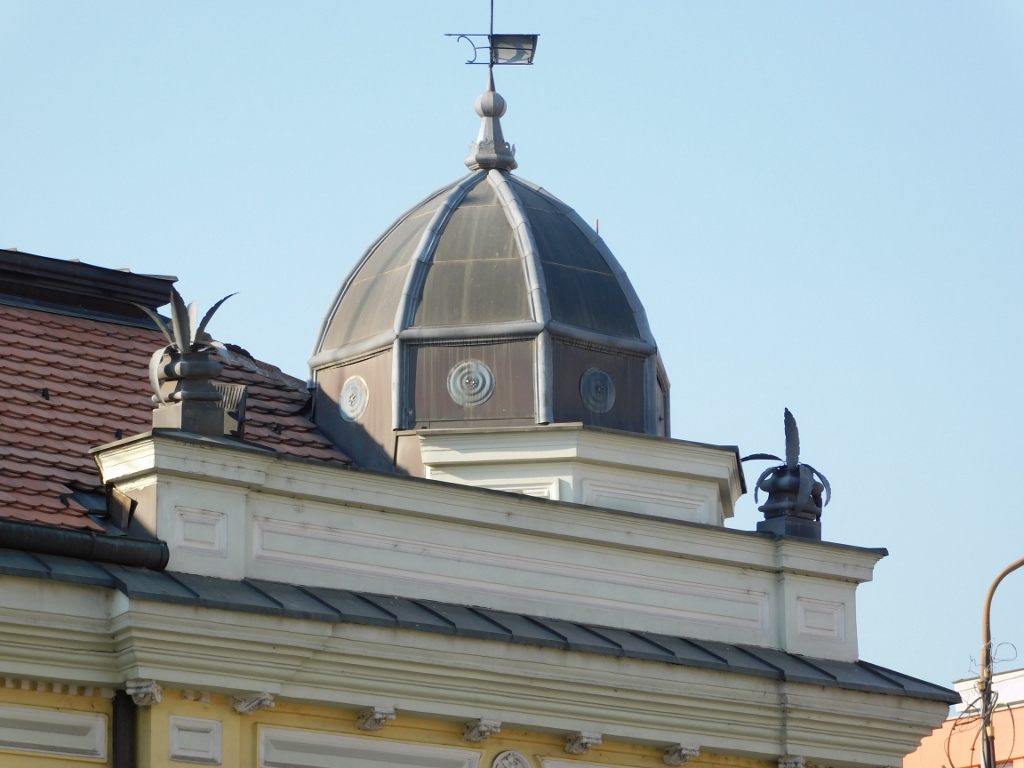 House of Aleksa Pušeljić, details
House of Aleksa Pušeljić, details
Unlike this edifice that is truly representative and is surrounded by a wide open space, the next one is its complete opposite and is squeezed between newer houses. And yet it is inscribed as a monument of culture. This is the house of National Hero Milica Pavlović and I believe that this is precisely the only or at least the main reason why this structure is considered a monument of culture. I certainly do not want to diminish in any way the importance of the national heroes or the 50 years of the history of my own country for that matter, since the national heroes were an integral part of the country’s socialist Pantheon. But, I also believe that the heroes of our past ought to be respected more, among other ways, by taking better care of the already declared monuments of culture linked to their lives in order for their status to make sense. Also, the materials I had claimed that the house was at number 33, while its number, as it can be seen, is 31.
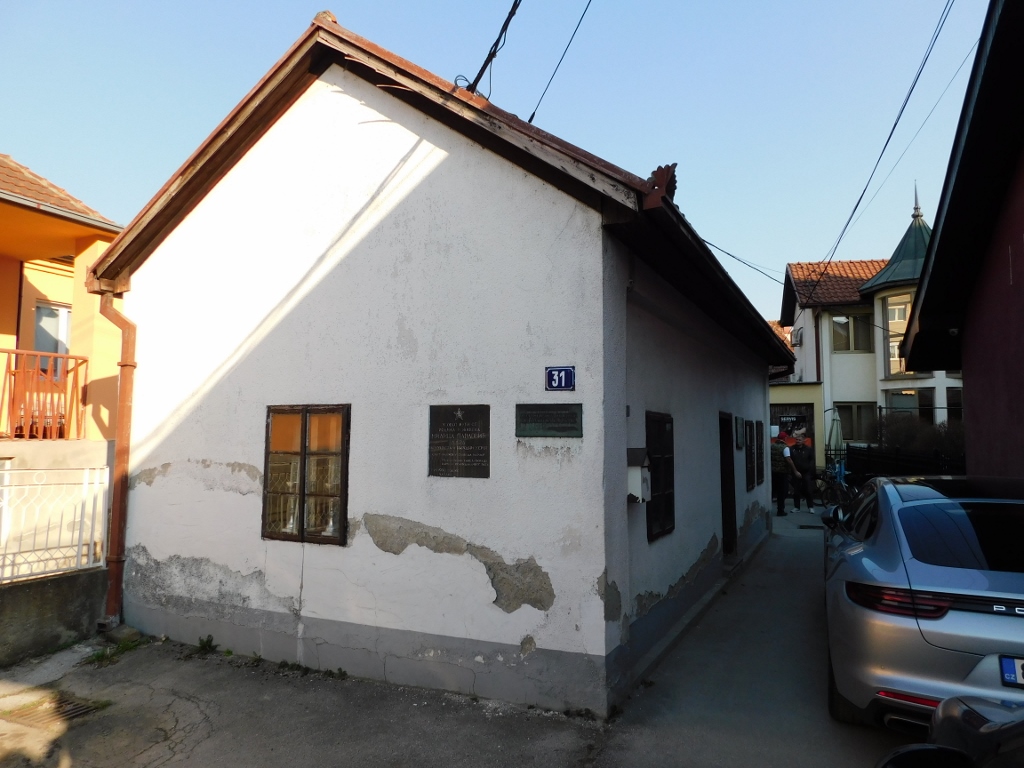 House of National Hero Milica Pavlović
House of National Hero Milica Pavlović
This was the house which in 1915 saw the birth of Milica Pavlović Dara who was a participant of the People’s Liberation Struggle, in other words she fought on the side of the partisans, during WWII. In June 1944, she was arrested by the Chetniks near Valjevo, who then tortured her for a few days and eventually killed her. They used their preferred method, which was slitting her throat. She was buried in Čačak.
Nowadays, her birth house is the place used by the Bicycle club “Borac.”
During this visit to Čačak I could not locate the next monument of culture, because again there was confusion in my materials concerning the name of the street in which the building was. It was only after I had returned home that, through additional digging, I managed to find out exactly where the house was. The absurdity of it all is that this is right next to the parking lot where I left my car while walking around the town. The accurate location is marked in the map that goes along these travel stories.
Here is the map again:
As for this monument of culture I’m talking about, the photo of which I don’t have, these are actually two houses at Gospodar Jovanova street nos. 7 and 9 which have had a change in their purpose over time. They are linked by an arched vehicle gate, thus creating an impression of an architectural and aesthetic whole. The houses belonged to prominent merchants from Čačak from the beginning of the 20th century.
The next time I go to Čačak I will know exactly both where I can leave my car and where I can see this monument of culture.